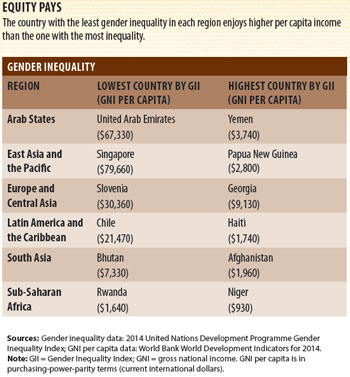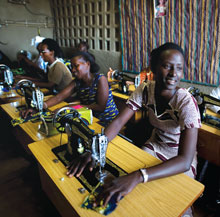Invest in Women and Prosper
Finance & Development, September 2017, Vol. 54, No. 3
David E. Bloom, Michael Kuhn, and Klaus Prettner
Investments in women’s health and education boost economic development

Investment in women’s education and health, and attention to their employment opportunities and empowerment, pays big dividends in terms of economic development.
However, gender equity is far from the global norm. In low-income countries, fewer girls than boys are in school (36 percent versus 45 percent); rates for female enrollment are particularly abysmal in Niger (17 percent) and South Sudan (7 percent). India spends less on women’s health than on men’s across all demographic and socioeconomic groups (Saikia, Moradhvaj, and Bora 2016). Globally, women have fewer opportunities to enter high positions in business and government. As of 2016, women held fewer than a quarter of parliamentary positions worldwide, and only 15 women are currently heads of state (excluding figureheads). Only half of working-age women are in the formal labor force compared with three-quarters of working-age men.
Rwanda is a notable exception. In the aftermath of the 1994 genocide that decimated the country and severely depleted its workforce, President Paul Kagame initiated a series of pro-women reforms. Gender rights are now enshrined in its constitution. Women fill nearly two-thirds of the seats in Parliament, comprise 52.5 percent of secondary school enrollees, and account for 54 percent of the workforce, with a salary gap between men and women that is the smallest in the world. Rwanda has invested heavily in maternal, newborn, and child health over the past two decades. The World Economic Forum’s 2016 Global Gender Gap Index ranked Rwanda fifth in gender parity, just behind Iceland, Finland, Norway, and Sweden and well ahead of Canada (35), the United States (45), and Australia (46). (However, traditional attitudes on gender roles still prevail in the domestic sphere, and domestic violence remains a significant problem throughout the country.)
These investments in women likely contributed to Rwanda’s recent economic success. Between 2000 and 2015, average income in Rwanda more than doubled, far outpacing average growth in the rest of sub-Saharan Africa.

There are other examples of the gender-development link. In each region of the world, the country with the least gender inequality (as measured by the United Nations Development Programme’s Gender Inequality Index) has higher gross national income per capita than the country with the greatest inequality (see table). It is hard to prove absolutely that gender equity affects economic development, but it is plausible and consistent with the facts (Diebolt and Perrin 2013).
Gender equity is a powerful indicator of economic growth and development. With prosperity come demand for labor and funding for health care and education, all of which encourage workforce participation and higher productivity. Economic security drives autonomy at home and in society.
This positive dynamic could encourage a wait-it-out approach to achieving gender equity, but such an approach poses at least three dangers. First, it falls short on human rights grounds: the promise of a more just society tomorrow neglects those harmed today. Second, it fails to account for the reality that no country, regardless of development status, has yet achieved complete equity. Third, it ignores the fact that gender equity can help promote growth and development, given the scale and multifaceted nature of women’s contributions to the economy. In fact, investment in women—particularly in their health and education—promises to pay substantial economic dividends.
Boost to the economy
Women contribute to economic growth and development directly and indirectly. The most direct route is via workforce participation, which boosts production—and thus income, savings, and tax contributions at the household, community, and national levels. The extent of the contribution depends on how many women enter the paid workforce, how many hours they work, and how productive they are. And productivity depends on education, training, and health.
Academic research supports the importance of education—particularly of women—to growth. Educated women enjoy more secure employment and higher wages (as much as 10 to 20 percent for each additional year of schooling). Educated women’s agricultural output is greater, and their mortality—and that of their children—is lower. A 2014 World Bank report by Claudio Montenegro and Harry Patrinos found that each additional year of schooling boosts women’s earnings by an average of 11.7 percent versus 9.6 percent for men. These results are consistent with macroeconomic evidence that gender inequality in education alone harms economic growth. Formal and informal on-the-job training also boosts workers’ skills and productivity. As technology favors brains over brawn in the labor market, education and training will carry even more weight.
Health matters too, particularly for women. Healthy women are more likely to work outside the home, have the stamina and energy for physical labor, and work more hours. Healthy girls can reap the full benefits of education, with implications for future productivity and earnings. Education encourages women to invest in their health, and good health increases the dividends of education through a longer life and better cognitive and physical functioning.
Legal, institutional, and cultural changes that increase access to capital, pay, and property ownership bolster women’s direct economic contributions via the labor force. Women who have control over their income are likely to work harder and longer.

Women also support the economy through unpaid labor, particularly at home. They bear children and often take—or are socially assigned—primary responsibility for child-rearing. They care for elderly family members and others in their household who need help. Women haul water, prepare food, do other household chores, and volunteer in the community. A 2015 United Nations Department of Economic and Social Affairs report estimates that women outwork men by an average of 30 minutes a day in developed economies and 50 minutes a day in developing economies.
Women contribute indirectly to economic growth, too. Investing in women’s human capital helps shift a society from high fertility to low fertility over the long term. Women who can earn income in the workplace have less of an economic incentive to raise large families, and surveys show that women generally prefer having fewer children who are better educated and healthier to having a larger number who are not. Women who have clout in society and at home can exercise that preference.
Such a fertility shift affects economic growth immediately and over the long haul. As fertility begins to decline, youth dependency falls, so society produces more per person, which opens the potential for a so-called demographic dividend: families can save and invest more, and the government can spend more on projects that promote economic growth. The first generation of children following fertility decline is also healthier and better educated and thus more productive than preceding generations. Over time, improved human capital catalyzes a transition from high fertility, low education, and poor health to low fertility, high education, and good health—and sustained economic growth. Fertility has decreased across all income groups over recent decades but is lowest in high-income and upper-middle-income countries, where the fertility shift and economic consequences have taken fuller effect.
Improvements in women’s health and household standing can spill over across the health, education, and well-being of other household members, particularly children. A recent review found that good maternal health benefits children’s cognitive development, behavior, and school performance as well as the health and productivity of other family members. According to earlier research, when women earn more and account for a larger share of household income, more household spending goes toward the health of the family, which positively affects the economy. For example, a study in Côte d’Ivoire showed that as women’s income increased, families tended to spend more on food and less on harmful products such as alcohol and tobacco (Hoddinott and Haddad 1995).
Women can be powerful instruments of social change. When women are healthy, educated, and empowered, they are more likely to take leadership roles in the community. Educating women fosters a transition to democracy, which may have its own positive effects on long-term economic prosperity. Educated women in the workforce may be less tolerant of gender inequity propagated by undemocratic political regimes and may push for more responsive leadership. Participation in the labor force also allows women to interact outside the domestic sphere and organize for political action.
Investments in women’s health and education can create a positive cycle in which societies take an increasingly favorable view of female labor force participation as more women begin to work. For example, men who grow up with working mothers are more likely to do their share at home, making it easier for women to work outside the home. These men are also more likely to have positive attitudes toward women’s participation in the paid labor force (Fernández, Fogli, and Olivetti 2004).
Make it happen
Countries that wish to invest in women and improve economic performance have many policy options. Funding education and health care is the obvious one.
Education is crucial. Lower school fees and conditional cash transfers for school attendance can help persuade families that sending girls to school is affordable. Running water, working toilets, and sanitary products in secondary schools encourage girls to attend, as does building more schools to cut down on travel time.
In addition to funding general health care, supporting women’s reproductive health can have profound economic consequences. Investing in family planning—for example, by supplying quality contraceptives—and implementing policies to delay the age of marriage, such as child marriage laws, can help lower fertility.
While the specific policy options enumerated here apply primarily to low- and middle-income countries, high-income countries are also likely to benefit from interventions to enable and encourage women’s productive involvement in the economy, especially in positions of leadership. Across all income groups, efforts to improve equity are most likely to bear fruit if they are implemented alongside general macroeconomic policies that foster efficient labor and capital markets and that offer basic worker protections.
An economic case
Collectively, health, education, empowerment, and economic well-being create a virtuous cycle. Investments in health and education are both important drivers of economic development on their own, but are dazzling when combined. This is true for women and men alike. But when ill health might otherwise keep women trapped in a cycle of poor education, the effects of such investment are stunning.
Human capital is among a country’s greatest assets. But it must be managed well to derive economic benefit. Women’s economic contributions—whether in paid or unpaid labor or in the form of smaller family size, more educated children, and more stable societies—can transform economic outcomes. Investing in women is not just the right thing to do. It’s also smart economics.
DAVID E. BLOOM is Clarence James Gamble Professor of Economics and Demography in the Department of Global Health and Population at the Harvard T. H. Chan School of Public Health. MICHAEL KUHN is coleader of the research group on population economics at the Wittgenstein Centre and Vienna Institute of Demography. KLAUS PRETTNER is the chair of the Growth and Distribution Unit at the University of Hohenheim’s Institute of Economics.
References
Diebolt, C., and F. Perrin. 2013. “From Stagnation to Sustained Growth: The Role of Female Empowerment.” American Economic Review 103 (3): 545–49.
Fernández, R., A. Fogli, and C. Olivetti. 2004. “Mothers and Sons: Preference Formation and Female Labor Force Dynamics.” Quarterly Journal of Economics 119 (4): 1249–99.
Hoddinott, J., and L. Haddad. 1995. “Does Female Income Share Influence Household Expenditures? Evidence from Côte d’Ivoire.” Oxford Bulletin of Economics and Statistics 57 (1): 77–96.
Saikia, N., Moradhvaj, and J. K. Bora. 2016. “Gender Difference in Health-Care Expenditure: Evidence from India Human Development Survey.” PLoS ONE 11 (7).


